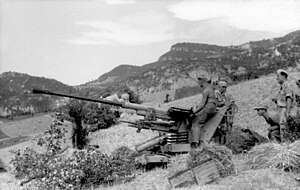
Back 3,7 cm Flak 18/36/37 Catalan 3,7-cm-Flak 18 German 3,7 cm FlaK 18/36/37/43 Spanish Canon de 3,7 cm Flak 18/36/37/43 French 3,7 cm FlaK 18/36/37/43 Hungarian 3,7 cm FlaK Italian 3,7 cm FlaK 18/36/37/43 Polish Flak 18/36/37/43 Portuguese Tun antiaerian Rheinmetall calibru 37 mm model 1939 Romanian 3,7 cm FlaK 18 Russian
| 3.7 cm Flak 18/36/37 | |
|---|---|
 A 3.7 cm Flak 36/37 in Italy, 1944 | |
| Type | Anti-aircraft gun |
| Place of origin | Nazi Germany |
| Service history | |
| In service | 1936–1945 |
| Used by | Nazi Germany, Romania, Bulgaria |
| Wars | World War II |
| Production history | |
| Designer | Rheinmetall |
| Produced | 1936–1945 |
| No. built | 20,243[1] (Germany) 360[2] (Romania) |
| Variants | BK 37 aircraft gun |
| Specifications (3.7 cm Flak 36/37[3]) | |
| Mass | 1,550 kg (3,420 lb) (combat) 1,250 kg (2,760 lb) (Flak 43)[1] |
| Barrel length | 2.11 m (83 in) (57 calibers) |
| Crew | 6–7 |
| Shell | 37 × 263 mm B |
| Shell weight | 623–659 g (1.373–1.453 lb) |
| Caliber | 37 mm (1.5 in) |
| Breech | gas-operated bolt |
| Carriage | three-legged platform |
| Elevation | -8° to +85° |
| Traverse | 360° |
| Rate of fire | 160 rpm (cyclic) |
| Muzzle velocity | 770–840 m/s (2,500–2,800 ft/s) |
| Effective firing range | 4,200 m (4,600 yd) (anti-aircraft) |
| Maximum firing range | 7,995 m (8,743 yd) (ground range) |
| Feed system | 6-round clips |
The 3.7 cm Flak 18/36/37 was a series of anti-aircraft guns produced by Nazi Germany that saw widespread service in the Second World War. The cannon was fully automatic and effective against aircraft flying at altitudes up to 4,200 m.[4] The cannon was produced in both towed and self-propelled versions. Having a flexible doctrine, the Germans used their anti-aircraft pieces in ground support roles as well; 37 mm caliber guns were no exception to that. With Germany's defeat, production ceased and, overall, 37 mm caliber anti-aircraft cannon fell into gradual disuse, being replaced by the Bofors 40 mm gun and later, by 35-mm anti-aircraft pieces produced in Switzerland.
- ^ a b Ivanov, A. (2003). АРТИЛЛЕРИЯ ГЕРМАНИИ ВО ВТОРОЙ МИРОВОЙ ВОЙНЕ (Artilleria Germanyi Vo Vtoroy Mirovoy Voyne) (in Russian). ОЛМА Медиа Групп. pp. 41–48. ISBN 978-5-7654-2634-0.
- ^ Third Axis - Fourth Ally, pag. 30
- ^ [1], The Encyclopedia of Weapons of World War II, Chris Bishop, pp. 167-8
- ^ Hogg, German Artillery of World War Two